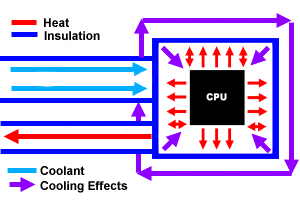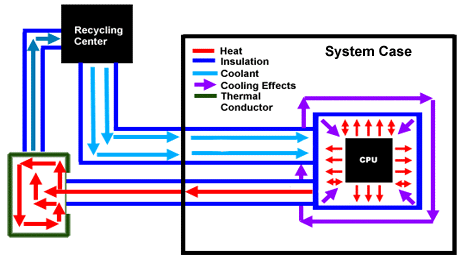Alternative Cooling at its Best
by Anand Lal Shimpi on October 24, 1998 2:46 PM EST- Posted in
- Cases/Cooling/PSUs
It's quite doubtful that you want the heat from your processor warming your case, and unless you have cold summers you probably don't want it filling your room with a warm gust of air every time you turn on the computer to surf the net. At the same time, it would be impractical to have the cooler be anything but self sufficient, the solution? Recycle the heat.

Figure 4. Thermal Exchange with an Outtake Valve
In removing the heat from the processor we've managed to put ourselves in a bit of a predicament, how do we cool the cooling system? The heat in the thermal conductor medium, in the example case, water, being channeled down the outtake valve coming from the processor (once outside of the case as to prevent the heating of any other components) needs to eventually be fed back into the loop via either a pump or a compressor (depending on whether you're using liquid or vapor based cooling, the latter being much more difficult) to keep the cooling cycle going and make the system self-sufficient. If the need for self-sufficiency didn't exist then one could theoretically continuously pump cold water over the CPU allowing the excess water to run down into your drainage system. If this were a perfect world, then we could all do just that, unfortunately attaching the kitchen sink to your computer isn't the most cost effective thing to do. The solution? Cool the coolant on the way back to the recycling center of the system, if you're using the water approach, that will most likely be a pump of some sort. Here's where you want to abandon the plastic tubing and pursue a more efficient thermal conductor for the outtake valve. Depending on the power of your recycling center and the diameter of the tubing used for the intake valve, the type of material and size of tubing you use for the outtake tubing will vary. Aluminum or copper are the two biggest contenders for this job, in the end it comes down to which material you can find more readily available, we're not going to hold an Aluminum vs Copper discussion here, however you're welcome to discuss the two solutions (engineers are definitely welcome ;)...) on the AnandTech BBS.

Luckily, the job of cooling the coolant (as that's what you're actually doing) isn't as difficult as cooling the processor. Allowing the heat to dissipate on its own works fine as long as you're using a heatsink-like construction on top of the outtake tubing, otherwise you may want to consider alternative methods such as other forms of passive cooling (air works perfectly fine here). The key to overclocking using this type of a system is keeping the coolant, whether it is water, anti-freeze, or any other liquid as cool as possible. So let the creativity flow and experiment with this, as we're on the verge of toppling a great barrier and the more minds working on the solution the better.










0 Comments
View All Comments